Pesticide usage - arable crops and potato stores 2018: survey results
Information from a survey of pesticide use on arable crops and potato stores in Scotland during 2018.
General trends
Crop area
The census area of arable crops grown in 2018 was 489,309 hectares (Table 28). This represents a one per cent decrease from 2016(3) to 2018 and an eight per cent decrease from 2014(4) to 2018. Since the last survey areas of winter rye, spring barley, winter oats, spring oats, oilseed rape and ware potatoes increased (55, 5, 4, 2 ,7 and 3 per cent respectively); while winter barley, wheat, seed potatoes and legumes have decreased (22, 9, 5 and 33 per cent respectively; Table 28, Figures 1 and 2).
In 2018, cereals accounted for 87 per cent of the arable area (51 per cent spring barley, 20 per cent wheat, eight per cent winter barley, five per cent spring oats, two per cent winter oats and one percent rye). The remaining area consisted of oilseed rape, potatoes and legumes (accounting for 7, 6 and <0.5 per cent respectively, Figure 3). The largest area of arable crops was in the Aberdeen region, followed by Angus, the Tweed Valley and Moray Firth (Figure 4).
Figure 1: Area of cereal crops grown in Scotland 2014-2018
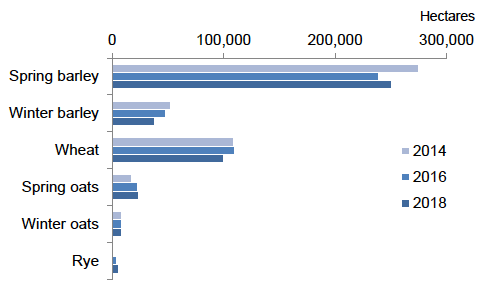
Figure 2: Area of oilseed rape, potatoes and legumes grown in Scotland 2014-2018
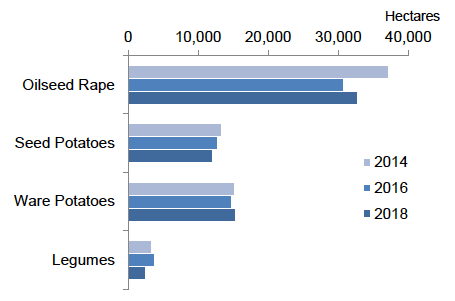
Note: oilseed rape includes winter and spring oilseed rape, legumes includes field beans and dry harvest peas
Figure 3: Arable crop areas 2018 (percentage of total area)
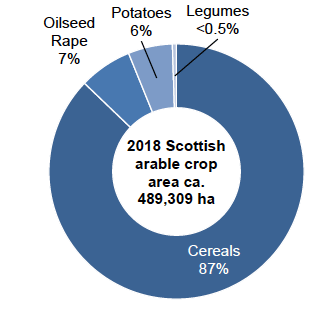
Note: cereals includes winter and spring barley, wheat, oats and winter rye; potatoes includes seed and ware potatoes; oilseed rape includes winter and spring oilseed rape; legumes includes field beans and dry harvest peas
Figure 4: Regional distribution of arable crops in Scotland 2018
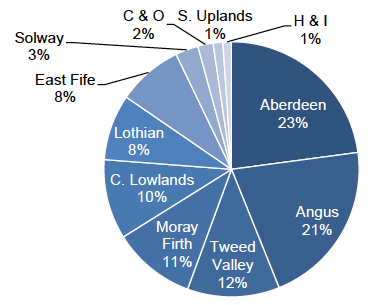
Note: H&I = Highlands and Islands, S. Uplands = Southern Uplands, C&O = Caithness and Orkney and C. Lowlands=Central Lowlands
Pesticide usage
In 2018, as in 2016, the majority of arable crops (98 per cent) received a pesticide treatment.
Winter and spring barley, winter and spring wheat, winter oats, oilseed rape and ware potatoes had the highest overall proportion of crop treated with a pesticide (between 98 and 100 per cent, Table 1). Spring oats, seed potatoes and legumes had lower proportions of treated crop area (94, 89 and 72 per cent respectively). The average number of sprays applied to treated arable land, excluding seed treatments, was 3.9; a small reduction on that recorded in 2016 (average 4.2 sprays). Ware potatoes received the highest average number of sprays (12.6) and spring crops of barley, oats and wheat the lowest (2.5 each, Table 1). These figures only apply to the treated area of crops.
It is estimated that the area of arable crops treated with a pesticide formulation in 2018 was ca. 4,632,066 hectares compared with ca. 4,851,771 hectares in 2016 and ca. 5,247,614 hectares in 2014 (Table 24, Figure 5). This represents a decrease of five per cent since 2016 and 12 per cent since 2014.
Figure 5: Area of arable crops treated with major pesticide groups in Scotland 2014-2018
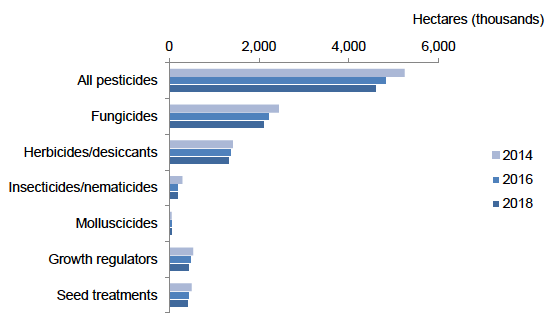
Note: Sulphur is not shown as it represents <0.5 per cent of the treated area
In terms of weight of pesticide applied, 1,312 tonnes was applied in 2018, representing a decrease of 12 per cent from 2016 and 13 per cent from 2014 (Table 24, Figure 6).
Figure 6: Quantity of major pesticide groups applied to arable crops in Scotland 2014-2018
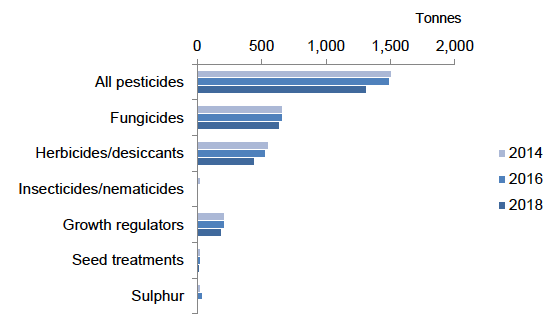
Note: molluscicides are not shown as their use represents under 10 tonnes.
In order to make accurate comparisons between the 2018 data and the data collected in previous surveys, it is important to take into account the differences in crop area between survey years. Therefore, the number of treated hectares per hectare of crop grown and the total weight of pesticide used per hectare of crop grown were calculated. Once crop area is taken into account, there is reduction in area of total pesticides applied between the surveys. There was a four per cent decrease both from 2016 to 2018 and from 2014 to 2018 in terms of the total pesticide treated area per area of crop grown (Figure 7).
Figure 7: Number of pesticide treated hectares (formulations) per hectare of crop grown in Scotland 2014-2018
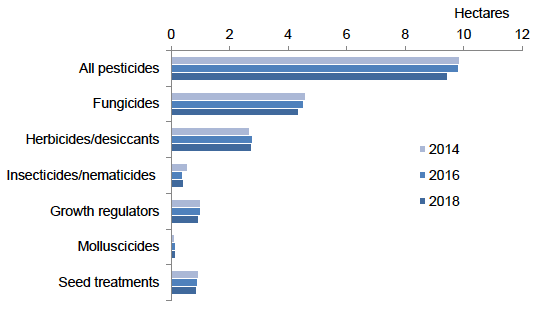
Note: sulphur is not shown as it represents <0.1 treated hectares per hectare of crop grown.
The 2018 season was challenging for farmers with a cold, wet start in spring followed by dry conditions over the summer; with some parts of Scotland receiving 75 per cent of their average annual rainfall total(5). Delayed drilling of spring crops and the inability to spray winter sown fields may have reduced overall applications. Also, the cold spring and hot dry summer may have led to reduced pressure from weeds, pests and disease.
In terms of quantity of pesticides used per hectare of crop grown, there was a decrease of 11 per cent from 2016 to 2018 and a decrease of six per cent from 2014 to 2018 (Figure 8).
Figure 8: Weight of pesticide applied per hectare of crop grown in Scotland 2014-2018
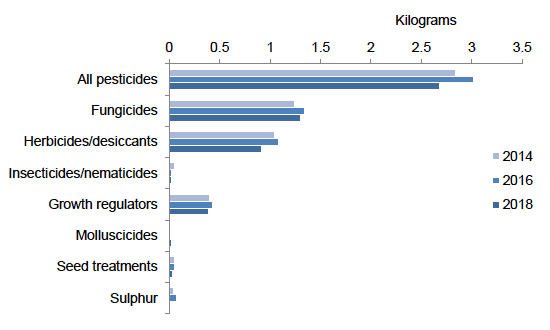
Fungicides were the most frequently used pesticides on arable crops, followed by herbicides/desiccants (Figure 5). This pattern has been observed in arable surveys for some time. In 2018, fungicides accounted for 46 per cent of the total pesticide treated area and 49 per cent of the total weight of active substances applied (Figures 9 & 10). When changes in crop area are taken into account, there was a four per cent decrease in area treated with fungicides from 2016 to 2018 and a five per cent decrease in area treated from 2014 to 2018 (Figure 7). The weight of fungicides applied per hectare decreased by three per cent from 2016 to 2018 but increased by five per cent from 2014 to 2018 (Figure 8).
In 2018, herbicides/desiccants accounted for 29 per cent of the total pesticide treated area and 34 per cent of the total weight of active substances applied (Figures 9 & 10). When changes in crop area are taken into account, there was a two per cent decrease in the area treated with herbicides/desiccants from 2016 to 2018 and a three per cent increase from 2014 to 2018. The weight of herbicides/desiccants applied fell by 15 percent from 2016 to 2018 and by 12 per cent from 2014 to 2018 (Figures 7 & 8).
The hot dry weather conditions in the summer months may have reduced the need for use of desiccants. When corrected for area of crop grown, the glyphosate treated area decreased by 14 per cent and the weight applied decreased by 19 per cent from 2016 to 2018. In addition, the area treated with diquat decreased by 30 per cent and the weight applied decreased by 39 per cent from 2016 to 2018. The authorisation for diquat has been withdrawn with final use for the product in February 2020. The decreased use of diquat on potatoes may also have been influenced by growers trialling different methods of haulm destruction in preparation for the loss of diquat.
Figure 9: Use of pesticide on arable crops - 2018 (percentage of total area treated with formulations)
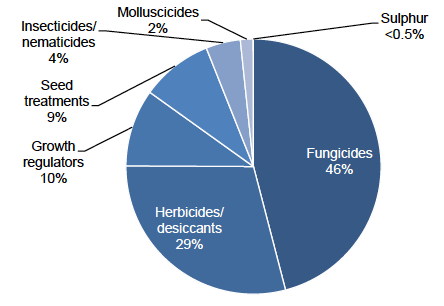
Insecticides accounted for four per cent of the total pesticide treated area and one per cent of the total weight of active substances applied (Figures 9 & 10). As in 2016, pyrethroids accounted for the largest area treated with an insecticide (87 per cent, Table 18). When changes in crop area are taken into account, there was a three per cent increase in area treated with insecticide from 2016 to 2018 and a 25 per cent decrease from 2014 to 2018 (Figure 7). The weight of insecticides applied per hectare of crop grown was found to have decreased by 30 per cent from 2016 to 2018 and by 68 per cent from 2014 to 2018 (Figure 8). The large decreases in weight of insecticides applied since the previous surveys is influenced by the loss of the active substance chlorpyrifos which was applied at high rates for the control of leatherjackets and wheat bulb fly in cereals crops. When changes in crop area are taken into account, insecticide use on oilseed rape in 2018 decreased 30 per cent by area treated since 2016. Insecticide use on oilseed rape in 2016 increased by 10 per cent by area treated from 2014 as a result of the loss of neonicotinoid seed treatments which meant growers were reliant on foliar insecticides for insect control during autumn crop establishment period.
Figure 10: Use of pesticides on arable crops - 2018 (percentage of total quantity of active substances applied)
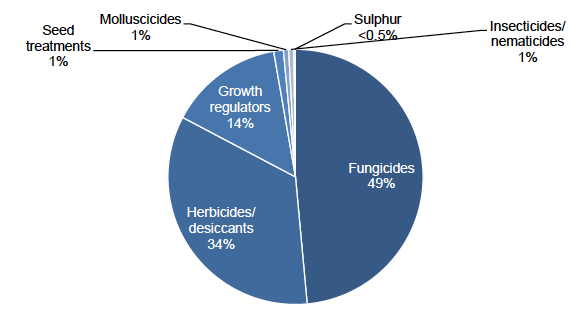
Molluscicides accounted for two per cent of the total pesticide treated area and one per cent of the total weight of active substances applied (Figures 9 & 10). When changes in crop area are taken into account, there was a ten per cent increase in area treated from 2016 to 2018 and a 50 per cent increase from 2014 to 2018 (Figure 7). The quantity of mollusicides applied per hectare of crop grown increased by 12 per cent from 2016 to 2018 and by 77 per cent from 2014 to 2018 (Figure 8).
Growth regulators accounted for ten per cent of the total pesticide treated area and 14 per cent of the total weight of active substances applied (Figures 9 & 10). When changes in crop area are taken into account, the area treated decreased by eight per cent from 2016 to 2018 and by seven per cent from 2014 to 2018 (Figure 7). The weight of growth regulators applied per hectare of crop grown decreased by nine per cent from 2016 to 2018 and by one per cent from 2014 to 2018 (Figure 8). The cold spring and resulting slow crop growth in 2018 may have reduced the requirement for the application of growth regulators.
Seed treatments accounted for nine per cent of the total pesticide treated area and one per cent of the total weight of active substances applied (Figures 9 & 10). When changes in crop area are taken into account, there was a six per cent decrease in area treated between 2016 and 2018 and an eight per cent decrease between 2014 and 2018 (Figure 7). The weight of seed treatments applied per hectare has decreased by 36 per cent from 2016 and by 35 per cent since 2014 (Figure 8). The decrease in the use of seed treatments, may relate to the withdrawal of some cereal seed treatment formulations in 2017, including prochloraz/triticonazole.
Sulphur accounted for less than 0.5 per cent of the total pesticide treated area and the total weight of active substances applied (Figures 9 & 10). When changes in crop area are taken into account, there was an 87 per cent decrease in area treated from 2016 to 2018 and an 88 per cent decrease from 2014 to 2018 (Figure 7). The quantity of sulphur applied per hectare of crop grown decreased by 93 per cent from 2016 to 2018 and 88 per cent from 2014 to 2018 (Figure 8).
Four active substances were recorded for the first time in the 2018 arable survey (Table 18). These included the herbicide imazosulfuron (for control of broad-leaved weeds in cereal crops) and the fungicides oxathiapiprolin (for blight in potatoes) and benzovindiflupyr (for cereal diseases). There was also a fungicidal seed treatment, sedaxane, used in cereals, which was encountered for the first time in this survey.
Whilst overall use of pesticides in 2018 has reduced slightly from the previous survey, some individual active substances have exhibited considerable changes. For example, there were substantial increases in the use of the herbicide halauxifen-methyl (32,228 per cent by area treated) on winter and spring cereals since the previous survey (Table 22). This was a relatively new active in 2016 and was only recorded once in the 2016 survey. Use increased in 2018 as one of the products containing this active substance was recommended as efficacious for weed control in cool conditions such as those encountered in the spring of 2018(6).
The main molluscicide active substance, metaldehyde, decreased by 20 per cent by area treated and 15 per cent by weight applied (Tables 22 & 23). This is likely to have been influenced by changes in authorisation for molluscicides. All products containing metaldehyde formed part of an enhanced stewardship plan from 2017 reducing its use(7). There has been an increase in ferric phosphate use (197 per cent by weight applied) in this survey as the only other chemical alternative for slug control. The herbicide, metobromuron has seen the highest increase in weight of active substance used (1,400 per cent). This active substance was included in two new products released at the beginning of 2015 for pre-emergence weed control in potatoes with some residual action(8) and was encountered in the 2016 survey on a very small area.
Contact
Email: psu@sasa.gov.scot
There is a problem
Thanks for your feedback